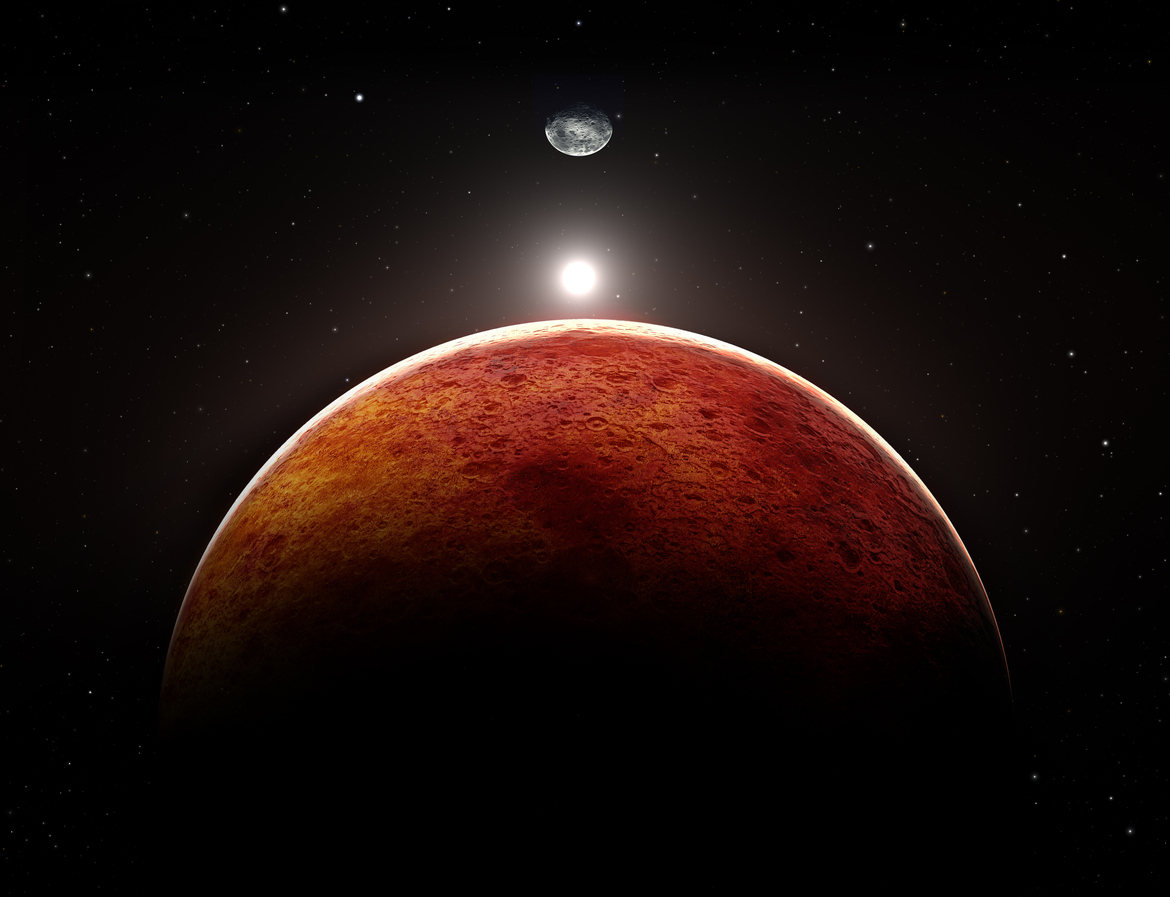Ever since the last Apollo mission a half-century ago, the great debate among space-flight enthusiasts has been about what mankind’s next big off-world goal should be: build human settlements on the Moon or make the much longer leap to colonizing Mars. Until the past few years, the argument has been mostly academic, given the lack of funding to accomplish either. But with the growing number of countries having launch capabilities, recent advances in space-flight technology, an apparent market in space tourism, and, perhaps most importantly of all, the willingness of a few tech billionaires to gamble their fortunes on interplanetary travel, the question of “Moon or Mars?” has become a serious one.
The debate is, indeed, coming to a head as 2022 will likely witness critical tests for rival launch systems. This summer, NASA is scheduled to send its Orion space capsule on an unmanned mission around the Moon. And later this year, SpaceX will attempt to orbit its gigantic Starship rocket, theoretically capable of carrying men to Mars.
“Space is sexy again,” as astrophysicist Paul M. Sutter put it (Discovery, Jan. 16, 2020). “After the excitement of the initial Apollo missions dwindled into a subject only discussed by ultra-nerds, and the cool factor of the Space Shuttle gave way to the realization that it didn’t really do much, people generally lost interest in space.” But now that “we’re back at it again,” he asks, should the Moon or Mars “be our next major goal in human space exploration?”
In terms of the engineering challenges involved, the case for the Moon is the stronger one. If for no other reason than its very proximity to Earth — a few days vs. 18 months away — our planet’s only natural satellite would be cheaper to reach and safer to occupy.
And the Moon, once more, could have a role to play in maintaining the free world’s military security. Early in 2021, the Defense Advanced Research Projects Agency (DARPA), a secretive research arm of the U.S. government, launched a program to encourage private companies to invent ways of manufacturing “large space and lunar structures” — presumably, antennas and telescopes to monitor the space-related activity of political adversaries.
There is even an environmental case to be made for the Moon, as much of its airless surface appears to be saturated with helium 3, an element carried by light waves from the sun that cannot survive the trip through Earth’s thick atmosphere. Mined by lunar colonists and transported in the bay of a cargo shuttle, helium 3 could theoretically provide the world a nuclear fuel that leaves no radioactive waste — an argument made for decades by geologist, U.S. senator, and Apollo 17 astronaut Harrison Schmitt.
When judged against these very practical arguments for choosing the Moon, the case for Mars comes up short — although not nearly as short as it did in 1989 when President George H.W. Bush gave NASA 90 days to come up with a post-Apollo agenda that included a Martian settlement. Operating under the assumption that everything a Red Planet colony might need, from oxygen to exercise machines, had to be brought from Earth, the agency came back with a recommendation to build a large fleet of interplanetary freighters along with service vehicles, docking bays, and orbiting fuel depots. Not surprisingly, the projected $450 billion price tag for what journalists dubbed Bush’s Battlestar Galactica plan (after a popular TV show) rendered it a political nonstarter.
The official name of Bush’s proposed project was the Space Exploration Initiative. And precisely because its estimated cost was so prohibitive, Robert Zubrin, a young Lockheed Martin engineer, began to expand on a radical idea that would eventually make colonizing Mars, if not cheaper than settling the Moon, far less expensive than generally thought. Since satellite and other unmanned reconnaissance of the Red Planet had revealed a wealth of indigenous resources, Zubrin reasoned, why not go with the minimum of hardware, planning instead to literally “live off the land”?
Iron from the soil, for example, could be combined with carbon in the Martian atmosphere to produce steel. Similarly, silicon from loose surface deposits could be used to make solar panels. As for water, there is likely more than enough in the form of subsurface frost. (More recent satellite and unmanned rover discoveries suggest that melting the planet’s underground ice could cover it to a depth of 115 feet.) The very fact of a day-night cycle nearly identical to ours — a Martian day is only 40 minutes longer than a day on Earth — means newly arrived colonists could start off on a planet already in harmony with their circadian rhythms.
Zubrin’s initial proposal for a Martian colony, as outlined in Scientific American (March 2000), called for no more than a modest number of small, four-person spaceships. The first of these would be sent to Mars under remote control, its return tanks empty of fuel and its crew cabin unoccupied. Landing on the surface, the unmanned spaceship would begin pumping the Martian atmosphere, which is 95 percent carbon dioxide, into a reaction chamber, where it would be exposed to hydrogen and broken down into water, oxygen, and a methane-based rocket fuel.
All these consumables would be stored inside the ship until months later when two more spacecraft — one carrying a human crew, and the other automated like the first — touch down on the planet’s surface. The astronauts could work on Mars for 18 months, living principally in their arrival craft, and at the end of their stay, abandon that ship, climb into the first robot lander, and blast off for home, leaving two spacecraft on the surface to serve as the hub for a permanent settlement.
From then on, Zubrin explained, the United States had only to launch two spacecraft every other year — one to bring four new astronauts to the Martian surface, and another to fuel up and prepare for the next crew’s return mission — to provide the infrastructure for a self-sustaining colony. Later astronauts could bring machines to heat and release carbon dioxide frozen in the Martian soil, thereby thickening the atmosphere to begin growing plants. To make Mars still warmer and wetter, volatile-rich asteroids from the asteroid belt could be diverted to slam onto the planet’s surface while drilling rigs simultaneously tap into the underground reservoirs of frozen water.
Zubrin was not the only space scientist in the late 1990s thinking along the lines of a destination-dependent Martian settlement. But unlike others, he saw the need to form an organization of geologists, biologists, engineers, tech investors, and even lay enthusiasts to take the data already coming from unmanned reconnaissance craft and brainstorm over the best use of indigenous materials. In 1998 Zubrin teamed with Apollo 11 astronaut Buzz Aldrin to launch the Mars Society, the subsequent annual conventions of which would challenge members to address questions ranging from how to mix Martian concrete to the optimal structure for an indoor fish farm. Within a few years, the opportunity to help design the first Martian colony out of local resources had attracted so many participants that the group’s membership eclipsed both the late Carl Sagan’s Planetary Society and the National Space Society.
At present, even those who insist on prioritizing the Moon readily concede that Zubrin’s decades-long push for a living-off-the-land strategy has made colonizing Mars far more affordable than what the elder Bush proposed. As Michael Meyer, lead scientist for NASA’s Mars Exploration Program, told a CNN correspondent in 2020, the question is no longer if settling Mars is economically viable, but when.
All this is not to suggest that the cost of establishing a permanent Martian colony is yet competitive with that of constructing a Moon base. For all its resources, the Red Planet does not appear to have any precious metals or energy deposits worth mining, its distance from Earth would likely discourage even those space tourists who could afford the roundtrip, and any military justification remains strictly in the realm of science fiction. But what bringing down the price tag for colonizing Mars has done in recent years is to make the fourth planet from the sun a seeming solution to several social and even metaphysical concerns.
Zubrin himself has become the modern spokesman for the view first articulated more than a century ago by historian Frederick Jackson Turner, namely, that many of the character traits we most admire — inventiveness, pragmatism, resilience, and discipline — are the result of having to negotiate a formidable frontier. In the case of early America, Turner said, it was not Old World tradition or racial stock that produced a dynamic egalitarian democracy but the continuous need to surmount the obstacles presented by its vast westward expanse. In Turner’s own words, “What the Mediterranean Sea was to the Greeks, breaking the bonds of custom, offering new experiences, calling out new institutions and activities, that and more the ever-retreating frontier has been to the United States.”
Today, Zubrin argues, it is the challenge of settling Mars that provides mankind its best opportunity to reverse an “ever more apparent loss of vigor,” “the spread of irrationalism,” “the banalization of popular culture,” and other signs of moral and intellectual decay. “[Only] Mars has what it takes,” he wrote in The Case for Mars (1996). “It’s far enough away to free its colonists from intellectual and cultural domination by the Old World, and unlike the Moon, rich enough in resources to give birth to a new branch of civilization.”
Mars has also become a focus of those who, since the beginning of the nuclear age, have been concerned not with redeeming character from the corruption of modern comforts but with providing mankind a backup plan in the event of global catastrophe. For these worst-case survivalists, the existence of a second habitable planet in our solar system has created the possibility of sheltering enough people from any ecological or military disaster in order to “preserve the light of consciousness,” in the words of their most famous contemporary spokesman, SpaceX founder Elon Musk. Life insurance for life, as it were.
From this perspective, it can never be enough merely to study Mars remotely with satellites and roving robots, no matter how sophisticated their instrumentation. For should circumstances on Earth seriously threaten human existence, only a self-sustaining presence on a completely separate world could guarantee its continuation. As Musk himself has said, “I wonder how many dead one-planet civilizations there are out there in the cosmos that never made it to the ‘other’ planet…that ultimately extinguished themselves or were destroyed by external factors.”
The third, and most explicitly religious, concern for which Mars has become the solution is the centuries-long decline in mankind’s view of its importance to the larger universe. Ever since the 1500s, when Copernicus and, later, Galileo and Kepler challenged Aristotle’s “sacred geography” of the skies with the Earth at the center of God’s creation, astronomy has increasingly marginalized our planet’s cosmic significance. First, science subordinated the Earth to the sun, then our sun to the galaxy, and, finally, our Milky Way galaxy to the incomprehensible vastness of billions of galaxies.
The spiritual problem with this educated view of man’s position in the universe is that it has greatly diminished the ancient conviction of a special relationship with the God who made him, even to the point of undermining many people’s faith in whether there is, in fact, a God. “Operationally,” as Julian Huxley famously observed in Religion without Revelation (1927), “God is beginning to resemble not a ruler, but the last fading smile of a cosmic Cheshire Cat.”
In the early 1960s, Princeton physicists Robert Dicke and John Wheeler, as well as Brandon Carter of the French National Centre for Scientific Research, thought they had found an alternative, non-spatial way of representing man’s special importance to the larger universe that might once again inspire, if not a biblical, at least a more spiritual outlook. Life on Earth is only possible, they argued, thanks to the delicate interrelationship of the known cosmological constants, including the force of gravity, the strength of weak nuclear forces within the atom, and the ratio of electron to proton mass. In other words, everything about the basic structure of material reality tends toward mankind, toward making life possible and sustaining it.
What eventually became known as the anthropic principle did, in fact, inspire some notable expressions of faith — at least among those who could appreciate the underlying math and science. “The more I examine the universe and study the details of its architecture,” physicist Freeman Dyson famously declared, “the more evidence I find that the universe in some sense must have known that we were coming.” Apollo 16 lunar module pilot Charles Duke expressed a similar sentiment. “To me,” he said, “the scientific evidence that we observe in the universe, the intricacies of life with all of its implications of intelligent design, the orderliness of the physical universe…all of these point to a designer, not to an accidental happening.”
But what also became clear was that if the idea of a universe especially designed for human flourishing were to have a broader public impact, it would have to be illustrated in a less technical way. It is not enough for people to hear about life as the unique byproduct of abstract material forces — they have to see concrete evidence of man’s ability to live and, more importantly, thrive beyond the fragile shelter of his seemingly obscure planet.
Today, those who worry about the spiritual consequences of man’s perceived cosmic demotion know that it can never be corrected with bases on the Moon. For however useful lunar colonies might be, their lack of access to sufficient local resources to ever become self-sustaining — indeed, their perpetual dependence on Earth for even the most basic supplies — would only reinforce the impression of the larger universe as an intrinsically difficult and uncaring environment.
Vibrant Martian settlements, on the other hand — communities that are not only self-sufficient but becoming ever more attractive, comfortable, and stimulating places to live — could indeed suggest a universe far more hospitable to man’s presence than most now imagine. Such colonies would, at the very least, invite us to think of the other worlds in our solar system not as immutably cold and dangerous realms but as environmental puzzles that our minds may have been granted the ability to solve.
Already the work that has gone into planning for the development of Martian colonies is changing attitudes toward Venus, a planet previously considered impossible to settle, let alone visit, due to its superheated carbon-dioxide atmosphere. Noting that Venus, like Mars, was once “a blue planet” with “a significant ocean,” NASA’s former top scientist, James Green, believes the second planet from the sun could someday be made habitable with a physical shield that reflects and deflects the sun’s light. “We create a shield,” Green told The New York Times (Jan. 2, 2022), “and the whole temperature starts to go down.”
And if it can be demonstrated that our very own solar system contains at least one and maybe two planets that can be “tweaked” to be made livable, how do people then begin to think about the estimated six billion Earth-size planets in our galaxy that orbit sun-like stars and move within zones that could either have or host liquid water? More importantly, how does the possibility of human viability on that vast number of worlds begin to change the average person’s thinking about man’s overall importance to the universe? As Aldrin said in 1999, the question of whether we merely exploit the Moon or aim to be self-sustaining on Mars is, beyond anything, “a spiritual question in the broadest sense, one promising a revitalization of humanity and a rebirth of hope.”
Realizing that the cost of settling Mars has been reduced to the point that social and even metaphysical considerations could influence the decision about where to go next, Moon boosters often try to clinch their case by describing the lunar surface as a waystation for deep-space exploration, suggesting, in other words, that going to the Moon first would give both camps what they want. Why head straight for the more difficult and riskier goal of colonizing Mars, their argument goes, when after a decade or two of living and working on the Moon, much more will be known about how to survive and prosper on the Red Planet?
Though the case sounds logical, the underlying economics are not. As David W. Brown, a journalist who covers space policy, has noted, “The tools necessary to do anything useful in the two environments are very different and require, for the most part, very different technologies — including, crucially, an entirely different landing vehicle to navigate the Martian atmosphere” (Wall Street Journal, Dec. 18, 2020). Merely landing on the Moon again, without even starting to build a base there, would cost $30 billion, with no benefit to Mars exploration.
Furthermore, the time and expense of planning to inhabit both worlds mean that whatever comes after the Moon could always be postponed or even canceled due to anything from a financial crisis to political gamesmanship. One need only recall the 1968 film 2001: A Space Odyssey, which took great pains to depict the spaceflight systems that scientists of the day were sure would follow the initial Apollo Moon program — but never did.
President Richard Nixon followed through on just enough of the planned space-shuttle program to ensure that its California contractors would support his campaign for a second term. Bill Clinton nixed any plans for further lunar exploration, settling for the completion of a modest International Space Station. And though George W. Bush tried to revive his father’s ambitious Moon-Mars project, Barack Obama wanted NASA to explore and mine asteroids instead, with Mars vaguely down the line.
As a practical matter, there is no guaranteed “both” in the choice of where to go next in space. It will be the Moon or Mars. And as Buzz Aldrin observed, the ultimate decision will essentially be a spiritual one.





